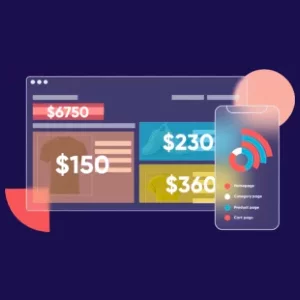
Take a product tour
Get to grips with Contentsquare fundamentals with this 6 minute product tour.

There’s plenty of great advice out there for brands about to embark on a website redesign. In this post, we share with you seven tips we believe are a crucial part of any website redesign process.
Unless you’re creating a new website from scratch, you are sitting on a treasure trove of information about how your audience connects with your brand digitally. Whether you’re planning to overhaul your platform or simply give it a makeover, start by learning every lesson you can from its past iteration.
Behavioral analytics can give you a sophisticated reading of how users engage with your site: What keeps them engaged, leads them to conversion, and causes them to bounce. Marketers today can measure the performance of—and attribute revenue—to every element of in-page digital content, including banners, buttons, form fields, etc.
Analyzing customer behavior helps you develop your marketing objectives around the very real needs and expectations of your digital audience.
Analyzing customer behavior helps you develop your marketing objectives around the very real needs and expectations of your digital audience—the only way to make sure your new platform is customer-centric by design. And since an in-depth knowledge of your users is the foundation for a successful user experience (UX), don’t pass on a chance to learn.
But this analysis shouldn’t stop after your website redesign. Using a platform like Contentsquare will help you continually optimize our website—even after launch. Data-driven insights will help you identify areas for improvement, like unclickable site areas with a high click recurrence, key features on our navigation bar that didn’t get the engagement you hoped for, and unintended customer journey loops that need to be smoothed out. Website redesign is an ongoing iterative process, don’t forget!
Take a product tour Get to grips with Contentsquare fundamentals with this 6 minute product tour.
Once you have a good idea of what worked and what didn’t work on your old site, now is the time to start planning what your new one will feel like. Brands today have become synonymous with the experience they offer online. Digital disruptors have raised the UX bar very high, and competition is such that users have no reason to persevere with a brand if their initial online connection is unsatisfactory.
Set clear, consumer-centric goals when planning your new site: what are the various goals visitors want to achieve on your platform? Do they want to purchase products? Find out information? Manage their checking account?
By determining which type of experience they seek, you can better develop a digital solution to ensure their objectives are met quickly and efficiently.

Every second visitors spend on your platform is a chance for you to connect with them, keep them engaged, and plant the seeds of loyalty. Think carefully about what you want to communicate to them during their visit. How will you impart your brand values, and make sure the experience is memorable – in a good way?
Think of your visitors as travelers journeying through your site with a purpose (or destination). What is the story of that journey? Where does it start, what are the various stages, and where do you want it to end? What needs to happen between the beginning and the finishing line? If your story is an e-Commerce story, for example, it will have different elements than if it is an online banking story.
Brands that can anticipate their consumers’ objectives will be better equipped to develop watertight plots that keep visitors engaged and guide them from start to finish.
Collaborating on a site redesign is a huge commitment–make sure you surround yourself with the right people before you embark on such a project. Identify who, internally, will be able to bring their expertise to the redesign. And if you are outsourcing the development and/or design, you must find an agency that understands your brand’s values and vision.
Facilitating a dialog between internal and external teams is also crucial–an outside contractor will want to take the company’s pulse by talking to its various teams.
When we went through a redesign at Contentsquare, we created a highly detailed Request for Proposal (RFP) that outlined exactly what would determine the success of the project. We only sent this RFP to select agencies with experience building B2B websites in our industry and came with personal recommendations from our professional networks.
Once selected, the agency started by getting to know our product and people, understanding the competitive landscape, learning about our current customers, and figuring out how the current site was being used. They also asked us at length about the future vision for Contentsquare. This stage of the process broke down into three steps:
Find out how Dune increased AOV by 14% following a data-driven site redesign using Contentsquare Digital Experience Analytics platform.
Mobile traffic is growing fast, and yet mobile conversions are not following, suggesting that many consumers today are left underwhelmed by the mobile experiences brands have developed for them.
Digital experiences must be imagined through the eyes of those who experience them, and those people are increasingly browsing on the go, on their smartphones.
Nowadays, it is no longer enough to just adapt your desktop site for mobile. Digital experiences must be imagined through the eyes of those who experience them, and those people are increasingly browsing on the go, on their smartphones. Creating a mobile-first site is about much more than fitting the same information into a smaller screen—think of where your users are when they access your site, what they might be doing, and what mindset they are in. Are they scrolling through sneakers on a subway platform? Are they checking out train fares for the weekend in the line at the deli?
Think of your favorite mobile sites and apps:

You’ve figured out what you’re going to do, how you’ll do it, and who will help you do it—now comes the fun part. But with tons of inspiring sites out there, it’s easy to get carried away and develop a mood board of clashing design trends.
Think of a website redesign as a house remodel. If you’re going with Danish minimalism in the living room, you probably don’t want flocked wallpaper and Renaissance furniture in the next room. Make sure your site is a cohesive house where all the rooms talk to one another and where you transition effortlessly into congruous environments.
Your site communicates your brand and its message. Make sure that message is clear, concise and withstands design trends, which change fast and often.
Many people still consider the homepage the front door to their website.
And yet data shows that many visitors will enter a site through a product page. It’s a bit like air travel —the check-in desk is still there if you need it, but most airlines today are pushing self-check-in. Another analogy is the museum information desk. If you want to head there to pick up a paper map, you can, but many people will choose to navigate the space spontaneously and head straight to the section they want to see.
Now, this of course, means that you need to find other ways to guide your visitors to where they want to be. In a museum, you might use signage. With a site, you must anticipate where your customers will want to head to next and create intuitive in-site paths that do not necessitate a return to the metaphorical ‘information desk.’
Connection is a two-way street. The more you know about your audience, the better equipped you will be to create meaningful experiences that will keep them engaged. And the more they know about you (and like what they see), the higher your chance of earning their loyalty. Clear communication of your values and message, combined with a user-centric approach to redesign, will lead you to a successful redesign.